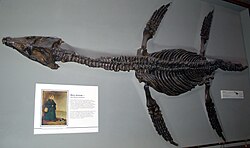Pliosauroidea
| Pliosauroids Temporal range: Hettangian - Cenomanian, 199.6–89.3 Ma |
|
|---|---|
 |
|
| Rhomaleosaurus cramptoni, Natural History Museum | |
| Scientific classification | |
| Kingdom: | Animalia |
| Phylum: | Chordata |
| Class: | Reptilia |
| Superorder: | †Sauropterygia |
| Order: | †Plesiosauria |
| Clade: | †Neoplesiosauria |
| Suborder: |
†Pliosauroidea Welles, 1943 |
| Families and genera | |
|
see text |
|
see text
Pliosauroidea is an extinct clade of marine reptiles. Pliosauroids, also commonly known as pliosaurs, are known from the Jurassic and Cretaceous periods. The pliosauroids were short-necked plesiosaurs with large heads and massive toothed jaws. These swimming reptiles were not dinosaurs, but distant cousins of modern turtles. They originally included only members of the family Pliosauridae, of the order Plesiosauria, but several other genera and families are now also included, the number and details of which vary according to the classification used.
The distinguishing characteristics are a short neck and an elongated head, with larger hind flippers compared to the fore flippers, vice versa of the plesiosaurs. They were carnivorous and their long and powerful jaws carried many sharp, conical teeth. Pliosaurs range from 4 to 15 metres and more in length. Their prey may have included fish, sharks, ichthyosaurs, dinosaurs and other plesiosaurs.
The largest known species are Kronosaurus and Pliosaurus macromerus; other well known genera include Rhomaleosaurus, Peloneustes, and Macroplata. Fossil specimens have been found in Africa, Australia, China, Europe, North America and South America.
...
Wikipedia
